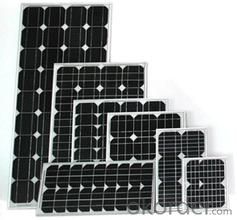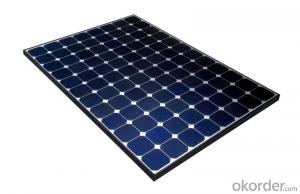Poly Solar Panel 100W A Grade with 12 Years Warranty
- Loading Port:
- Shanghai
- Payment Terms:
- TT OR LC
- Min Order Qty:
- 100 watt
- Supply Capability:
- 1000 watt/month
OKorder Service Pledge
OKorder Financial Service
You Might Also Like
Item specifice
Poly Solar Panel 100W A Grade with 12 Years Warranty
Production description
PV systems range from small, rooftop-mounted or building-integrated systems with capacities from a few to several tens of kilowatts, to large utility-scale power stations of hundreds of megawatts. Nowadays, most PV systems are grid-connected, while off-grid or stand-alone systems only account for a small portion of the market.The International Energy Agency projected in 2014 that under its "high renewables" scenario, by 2050, solar photovoltaics and concentrated solar power would contribute about 16 and 11 percent, respectively, of the worldwide electricity consumption, and solar would be the world's largest source of electricity. Most solar installations would be in China and India.[2]
It may also use a solar tracking system to improve the system's overall performance and include an integrated battery solution, as prices for storage devices are expected to decline. Strictly speaking, a solar arrayonly encompasses the ensemble of solar panels, the visible part of the PV system, and does not include all the other hardware, often summarized as balance of system (BOS). Moreover, PV systems convert light directly into electricity and shouldn't be confused with other technologies, such as concentrated solar power or solar thermal, used for heating and cooling.

Application
Commercial
Industrial
Residential
Product Feature
12 years quality warranty 25 years performance output.
Free for less than 5 pcs sample requirement
Free to replace or repair or refund if products fail to conform to the PI requirement.
Packaging
28pcs into carton 2carton into pallets 28pallets into a 40ft container
Delivery
After 25 days for manufacturered goods as soon as we received full payment.
After 10 days for stock goods as soon as we received full payment.
- Q:What do the solar cell suppliers provide once we purchase the order from the solar cells from them.
- There is a technical term called turnkey project, which is somehow the solar cell suppliers will provide more than selling the solar cells to you.
- Q:How is the efficiency of a solar cell calculated?
- The efficiency of a solar cell is calculated by dividing the electrical power output of the cell by the incident solar power input. The formula for efficiency is Efficiency (%) = (Power output / Power input) x 100.
- Q:Can solar cells be used in schools or educational institutions?
- Yes, solar cells can definitely be used in schools or educational institutions. They provide a practical and hands-on way to teach students about renewable energy sources, sustainability, and environmental stewardship. Installing solar cells in schools can also help reduce electricity costs and promote energy efficiency, making it a beneficial investment for educational institutions.
- Q:Can solar cells be used in street lighting?
- Yes, solar cells can be used in street lighting. Solar street lights combine solar panels, batteries, and LED lights to generate and store energy during the day, which is then used to power the lights at night. This renewable energy source makes solar cells an efficient and sustainable option for street lighting, reducing carbon emissions and reliance on the electrical grid.
- Q:Can solar cells be used to power cars?
- Yes, solar cells can be used to power cars. Solar-powered cars utilize photovoltaic technology to convert sunlight into electricity, which is then used to power the vehicle's electric motor. While solar-powered cars are still in the early stages of development and face challenges such as limited energy storage and efficiency, advancements in solar technology hold promise for their future use in powering cars.
- Q:Can solar cells be used for powering schools?
- Yes, solar cells can be used to power schools. Solar energy is a renewable and sustainable source of power, and installing solar panels on school rooftops or grounds can generate electricity to meet the energy needs of schools. This can significantly reduce the reliance on fossil fuels and decrease carbon emissions, making it an environmentally friendly solution. Additionally, solar power can provide a reliable and consistent energy source, especially in sunny regions, ensuring schools have a stable power supply.
- Q:Can solar cells be used for powering communication towers?
- Yes, solar cells can be used for powering communication towers. Solar panels can convert sunlight into electricity, which can then be used to power various devices and systems, including communication towers. This renewable energy source provides a sustainable and cost-effective solution for powering communication infrastructure in remote areas or areas with limited access to the grid. Solar-powered communication towers have become increasingly popular as they are environmentally friendly and can reduce reliance on traditional energy sources.
- Q:How do solar cells handle temperature fluctuations?
- Solar cells generally handle temperature fluctuations well, but extreme temperatures can have an impact on their performance. In cold temperatures, solar cells tend to have slightly higher efficiency, meaning they can produce more electricity. However, excessive heat can cause a decrease in efficiency and even damage to the cells. To counteract this, solar panels are designed to dissipate heat effectively and are often installed with a gap between the panels and the roof to allow for better airflow. Additionally, some solar cell technologies, such as thin-film solar cells, are less susceptible to temperature variations compared to traditional crystalline silicon cells. Overall, while solar cells can tolerate temperature fluctuations, it is crucial to consider and manage heat buildup to ensure optimal performance and longevity.
- Q:What is the payback period for solar cells?
- The payback period for solar cells refers to the amount of time it takes for the cost of installing and maintaining solar cells to be recouped through the savings generated from reduced or eliminated electricity bills. Typically, the payback period for solar cells ranges from 5 to 10 years, depending on factors such as installation cost, energy consumption, government incentives, and regional sunlight availability.
- Q:We are currently promoting our one of our solar cells seriers, which is the 156mmx156mm 6inch,2BB/3BB polycrystalline/multi solar cells,mono solar cell,made in Taiwan/Germany, please feel free to contact me if any interest.
- Sounds interesting, how about the price and order requirements for this kind of solar cell?
1. Manufacturer Overview |
|
|---|---|
| Location | |
| Year Established | |
| Annual Output Value | |
| Main Markets | |
| Company Certifications | |
2. Manufacturer Certificates |
|
|---|---|
| a) Certification Name | |
| Range | |
| Reference | |
| Validity Period | |
3. Manufacturer Capability |
|
|---|---|
| a)Trade Capacity | |
| Nearest Port | |
| Export Percentage | |
| No.of Employees in Trade Department | |
| Language Spoken: | |
| b)Factory Information | |
| Factory Size: | |
| No. of Production Lines | |
| Contract Manufacturing | |
| Product Price Range | |
Send your message to us
Poly Solar Panel 100W A Grade with 12 Years Warranty
- Loading Port:
- Shanghai
- Payment Terms:
- TT OR LC
- Min Order Qty:
- 100 watt
- Supply Capability:
- 1000 watt/month
OKorder Service Pledge
OKorder Financial Service
Similar products
New products
Hot products
Related keywords

























